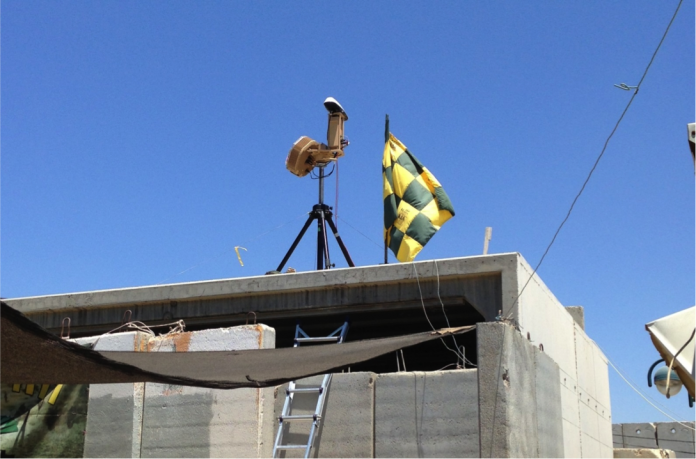

‘Hybrid Warfare’ insurgency rely on the integration of advanced capabilities (precision effects, command, control and coordination) while negating the military forces’ superiority in Intelligence, Surveillance and Reconnaissance. By denying the military the ISR producing target locations for standoff precision attacks, insurgents force a superior military power to strip out of most of its advantages, to fight the insurgents in high attrition, close-in battles, which would take a toll in time, casualties, financial cost and morale.
Facing such hybrid warfare, modern military forces are relying on small and agile elements of military or special forces to carry our the fight. These teams are often providing the coordination and target acquisition elements controlling and guiding powerful, precision effects delivered from stand-off distance by aerial or fire support. When regular combat units that are required to fight in such hybrid warfare they must be equipped with the tactical means improving their capabilities to operate in terms of uncertainty and quickly respond to surprise attacks.
New technologies are key to achieving tactical superiority, by improving force protection, regaining the manoeuvring capability necessary to generate the ‘friction’ that would draw insurgents to respond and fight, thus giving away their main advantage – stealth and surprise. Taking advantage of such ‘friction’ tactics require adequate sensors and intelligence, providing the combat forces at the lowest combat echelons with real-time situational awareness, through the use of advanced sensors, and reliable networking enabling rapid and accurate response to defeat the threats, using smart and precise weapon systems, deployed with the forward most elements and controlled by those units.
Airborne and forward deployed sensors were considered a must for such tactics, but they require complex coordination and assured air supremacy which cannot be guaranteed everywhere. While EO sensors offer an excellent capability detecting visible targets, they are quite limited in persistently covering large areas to provide early warning on incoming attacks. Radars are providing these services much more effectively, but in the past, analog-only radars could carry out those tasks one by one, as often they were tailored for specific tasks.
Air surveillance radars, even those designed to detect and track fast jets or helicopters at low altitude are not well equipped to detect small, slow flying targets such as drones, ultralight aircraft (ULA) or gliders. In contrast, ground surveillance radars, designed to detect personnel or vehicles on the ground are not capable of alerting on enemy direct or indirect fire coming at them. These services are provided by yet another type of radar – Counter-Rocket, Artillery and Mortars (C-RAM) radars, that provide effective early warning from such attacks, but are often quite bulky and heavy, require complex networking to distribute early warning on imminent attacks, and are often useless protecting tactical units attacked from close range by mortars or direct fire.
With digital, phased arrays becoming smaller and lighter, ‘multi-mission’ radars are reaching the field – Elta’s Multi Mission Radar (MMR), Giraffe AMB from Saab and Northrop Grumman’s G/ATOR are all examples of tactical radars that are powerful and capable of supporting combat forces from a stand-off distance. To be affordable these systems utilise common, commercial off the shelf (COTS) hardware enabling the military to deploy such systems at corps and division level, and in support of contingency operations.
Their multi-mission capability is derived by advanced signal-processing and algorithms enabling automated performance. As relatively large systems, these assets are often deployed on trucks, positioned at stationary sites to support the division area of responsibility.
While those assets are providing essential support for the division level, there is still a need for similar support provided integrally to the tactical level, particularly when operating in complex terrain where line of sight and other obstacle impair the coverage by stand-off sensors. These capabilities are now becoming available, with the appearance of radars for the manoeuvre forces.
Such tactical radars operated as an organic asset with the combat element are required to deliver threat warning in real time, enabling the troops to take cover, evade the attack or respond with effective counterstrike. To support these functions the system should be able to detect direct fire and ballistic threats, calculate the location of the source of fire and projected impact point, determining the relevance to the protected units. These radars are designed to operate on the move, and perform a multitude of missions automatically, exclusively by software control.
Israel’s defense electronics manufacturer RADA has developed a full line of such ‘manoeuvre radars’ comprising of two basic families: the Compact Hemispheric Radars (CHR) and Multi-mission Hemispheric Radars (MHR) Families. As a manoeuvre tactical radar, the CHR can be used for vehicle active protection, while some of the MHR variants provide ground based air defense, supporting VSHORAD missiles, and providing C-RAM early warning for mobile forces. Operating in static deployments MHR provides short range C-RAM alerts, conduct perimeter security applications or be used as a sectorial gap filler. Both families are based on identical, interchangeable subsystems, thus simplifying support and reducing cost.
Employing modern Active Electronically Scanned Array – AESA antennae technology, these radars provide extremely fast volume coverage performing target search, classification and tracking. Innovative angular measurements techniques are used to overcome the small antenna size, along with Pulse-Doppler processing, and digital, adaptive beam forming, enabling a single radar to monitor a wide range of threat velocities.
By electronically stirring multiple beams the radar performs track while scan over a full hemispheric coverage, including very high elevations angles, required for ballistic trajectory calculations of typical RAM targets. It also provides real-time range and angle measurement required to support APS.
These software controlled radars are offering beam forming to control the spatial coverage, order of beams and their waveform, to tailor the radar for multiple missions either as a dedicated system or an ‘all in one’ sensor, interleaving several missions over certain periods of time. Switching between missions can be programmable, predefined, upon real-time events or manual.









